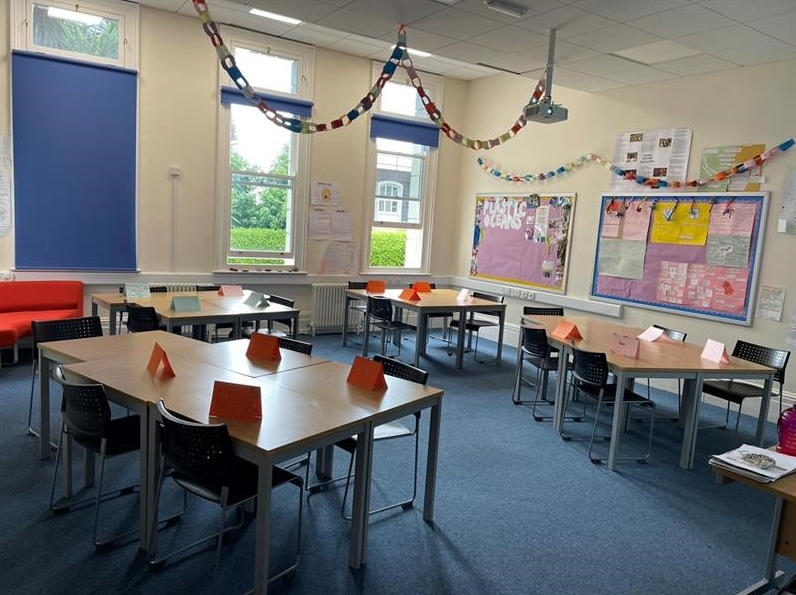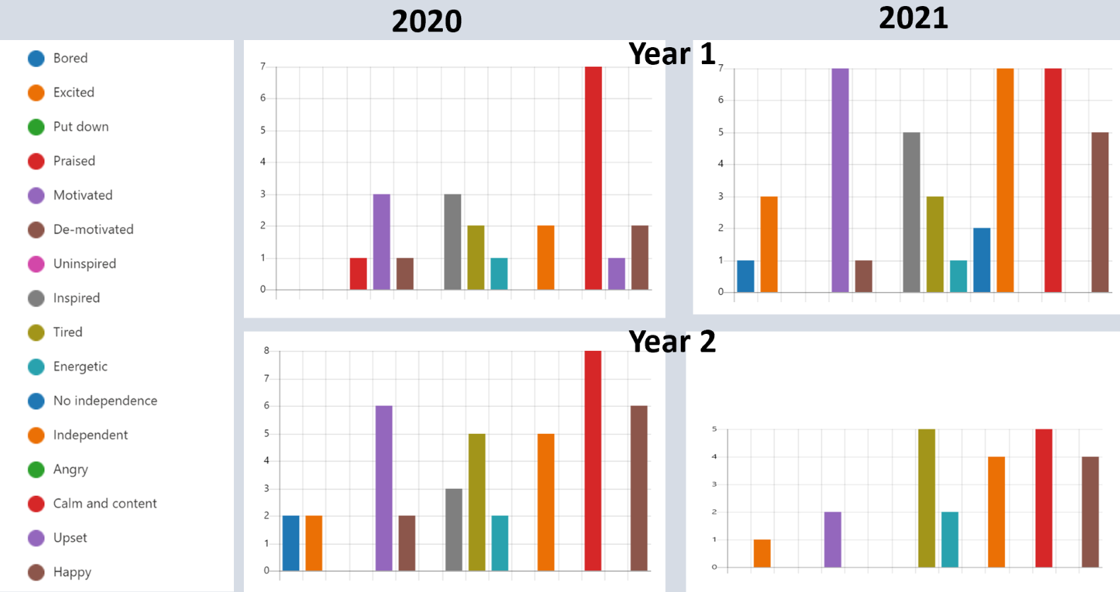What impact does the learning environment have on learner engagement?
As part of the Advanced Teacher Status (ATS) programme, participants are required to undertake a quality improvement project.
SET’s Professional Status team reviewed all 60+ quality improvement projects submitted as part of the October 2020 ATS cohort, shortlisting the best 12 using a scoring matrix, including the below from Tanya Miller, Lecturer at Highlands College, Jersey.
This editorial provides an overview of Tanya’s improvement project which focused on the role of learning environments – both online and physical – in learner engagement.

Research context
To maintain consistent education, throughout the Covid-19 pandemic, Highlands College transitioned to an online and blended learning approach. It was noticed that learners’ engagement was much lower in online lessons than in the physical learning space, which led Tanya to investigate the impact that the learning environment has on learner engagement and achievement. She examined what increased learners’ engagement in the physical learning space, paying particular attention to the development of contextual learning environments.
Aims and objectives
- To investigate if the learning environment impacts learner engagement in physical and online classrooms.
- To investigate how to improve learner engagement through management of the learning environment.
- To aid development of subject-specific learning/base rooms to enhance engagement across the college.
Methodology
The data for this project was gathered from a range of sources:
- Departmental discussions about students’ lack of engagement in online lessons.
- Use of the college’s QDP student experience surveys – interpretation of online learning data and the in-classroom learning data for both year groups of Animal Management.
- Microsoft Forms research questionnaire for students in three departments about their feelings on what affected their achievement and engagement in both online and in-college lessons.
- Cross-college CPD focus group to ascertain the experiences of other departments with online learning, the classrooms at college and how to develop learning spaces to potentially enhance engagement.
- Microsoft Forms survey for Animal Management students to gain a better insight into the impacts that an immersive learning subject-specific base room could have on engagement.
- Assisting the development of three other base rooms for immersive learning.
- Involvement in a cross-college Professional Standards project to improve shared spaces and develop learning areas.
- Development of the Animal Management classroom and assisting with the development of Health and Social Care, ESOL and Life Skills classrooms.
- Meeting with the Vice Principal regarding the timetabling of departments and the introduction of base/subject-specific rooms across the college.
Project findings
The results indicated that many students do not have a safe and designated learning space at home. According to Maslow (stated in Bates 2016), this will restrict their capacity to learn. The students reported more distractions from their home learning environment, such as animals, phones and games. The students also highlighted their experiences within the physical classroom when they were introduced to a new room, seating plan or table layout. This caused feelings of anxiety amongst 60% of learners.
After converting a base room from an English and Maths room to an animal-focused, student-led environment, it was found that the majority found the lesson and activities excellent instead of OK (from the previous study). The students’ impressions of peers improved and 70% of students found the tutor excellent rather than 10% (the figure before the transformation of the room). Feelings of excitement, independence and happiness all increased; 56% of the class felt inspired and 78% motivated in the session in the new room, and feelings of de-motivation and boredom were gone.

Results of the Year 1 & 2 Animal Management students in response to developing their base room. (The results represent data from before the room was developed in comparison to afterwards.)
Results of the Year 1 & 2 Animal Management students in response to developing their base room. (The results represent data from before the room was developed in comparison to afterwards.)
The conclusions that can be drawn from this study indicate that the students, especially the first years, have benefited emotionally from the base room. They are more motivated and inspired to learn. They are happy in the space and the majority find the tutor, lesson and activities excellent. Peer relationships have noticeably improved as have the group dynamics. Having a structured and immersive learning environment where the students are surrounded by the context of their course enables them to function under a reduced cognitive load, whereby they feel comfortable in their learning environment so are more likely to learn and succeed (Choi et al 2014).
The students took ownership over the design and decoration of the base room. According to Butler (2010), giving students ownership of the classroom has a considerable impact on motivation and achievement. After the redesign, students’ responses included improved motivation, punctuality, confidence, and overall achievement.
Students in Health and Social Care and Child Care were happier to learn online and enjoyed learning in their own surroundings. Animal Management students, however, struggled with online learning and were far more focussed on learning in a classroom environment. This may be due to the practical nature of the Animal Management course and the inability to implement this fully into an online distance learning model.
Recommendations
- Where possible all subjects should have a base room which should stimulate learning and ownership of a subject area.
- All subject year groups utilising the room should have a say in what is included to encourage learners to identify with their subject and be proud of their learning environment.
- The room should be updated to include current contributions.
In addition, it will be important to:
- Recognise that ownership of a space improves motivation and mood.
- Work towards showcasing the creative learning environments for each department to employers and external stakeholders.
- Continue to strive towards improving and updating learning environments to promote sustained motivation, engagement, achievement and retention.
- Develop an online learning environment/virtual classroom for online/blended learning.
Professional Standards covered
PS1, PS2, PS3, PS4, PS5, PS7, PS8, PS9, PS10, PS11, PS12, PS14, PS17, PS18, PS19, PS20
View all 20 Professional Standards.
Professional reading
Appleyard, N. and Appleyard, K. (2010). Communicating with Learners in the Lifelong Learning Sector. Exeter: Learning matters Ltd.
Blass, E. and Davis, A. (2003). ‘Building on solid foundations establishing criteria for e-learning development.’ Journal of Further and Higher Education 27(3).
Barrett, P., Davies, F., Zhang, Y. and Barrett, L. (2015). ‘The impact of classroom design on pupils' learning: Final results of a holistic, multi-level analysis.’ In Building and Environment: Volume 89, pp.118-133.
British Educational Research Association (BERA, 2017). BERA Handbook: Member Code of Conduct. London: BERA.
Butler K. (2010). Using a creative learning environment to improve motivation and achievement in learners. Coventry: LSIS Research.
Businessballs (2019). Johari Window Model and Free Diagrams. [Online] Available at: https://www.businessballs.com/self-awareness/johari-window-model-and-free-diagrams/ [Accessed 29 April 2020]. London: Businessballs Ltd.
Chow, S. J. and Yong, B. C. S. (2013). ‘Secondary School Students’ Motivation and Achievement in Combined Science.’ US-China Education Review B, ISSN 2161-6248, Vol. 3, No. 4, pp. 213-228.
Cao W., Fang Z., Hou G., Han M., Xu X, Dong J., Zheng J. (2020). ‘The psychological impact of the COVID-19 epidemic on college students in China.’ Psychiatry Research: Vol. 287. Science Direct.
Education and Training Framework (ETF), 2018. Taking Learning to the Next Level. [Online] Available at: https://www.et-foundation.co.uk/professional-development/edtech-support/
Education and Training Foundation (ETF, 2018). Digital Teaching Professional Framework. [Online] www.et-foundation.co.uk/supporting/edtech-support/digital-skills-competency-framework [Accessed 17 August 2021]
Gregson, M., and Hillier, Y. (2015). Reflective teaching in further, adult and vocational education (4th edition). London: Bloomsbury.
Hanrahan, M. (1998). The effect of learning environment factors on students' motivation and learning. International Journal of Science Education 20 (6) pp. 737-753. [Online] Available at: https://www.researchgate.net/publication/27463856_The_effect_of_learning_environment_factors_on_students'_motivation_and_learning [Accessed 15 January 2021]. Oxon: Taylor & Francis Group.
Hill, C. (2008). Teaching with e-learning in the Lifelong Learning Sector (2nd edition). Exeter: Learning Matters Ltd.
Moustapha, A. (2015). Pranks and tricks we mastered at school. [Online] Available at: https://identity-mag.com/pranks-and-tricks-we-all-mastered-at-school/ [Accessed 23 May 2021].
IED team (2018). Motivating your employees. [Online] Available at: https://ied.eu/project-updates/motivating-your-employees/ [Accessed 23 May 2021]. Larissa, Greece: Institute of Entrepreneurship Development.
Johnson, A. M., Jacovina, M. E., Russell, D. E. and Soto, C. M. (2016). Challenges and solutions when using technologies in the classroom. [Online] Available at: https://files.eric.ed.gov/fulltext/ED577147.pdf. Arizona State University.
Kuepper-Tetzel, C. (2020). Moving towards online teaching: a reflection. [Online] Available at: https://www.learningscientists.org/blog/2020/9/24-1 [Accessed 03 January 21]. The Learning Scientists.
Machin, L., Hindmarch, D., Murray, S. and Richardson, T. (2017). A complete guide to the Level 5 Diploma in Education and Training (2nd edition). Plymouth: Critical Publishing.
Crossley, S. A. and McNamara, D. S (2020). Adaptive educational technologies for literacy instruction, pp. 13-29. New York: Taylor & Francis. Published with acknowledgement of federal support.
Stevens, G. (2020). Teaching in the Post Covid Classroom (1st edition). Red Lotus Books.
Thedham, J. (2018). Coaching and mentoring in action: additional approaches, tools and techniques. [Online] Available at: https://repository.excellencegateway.org.uk/OTLA-AP-guide-CoachingMentoringAction-Final_01.11.18.pdf [Accessed 13 March 2021]. London: The Education and Training Foundation (ETF).
Petty, G. (2017). ‘Affecting the disaffected.’ InTuition Journal, Issue 27, p31.
Rizkallah, E. and Seit, V. (2017). ‘Understanding Student Motivation: A Key to Retention in Higher Education.’ Scientific Annals of Economics and Business, Vol 64, pp. 45-57. [Online] Available at: DOI: 10.1515/saeb-2017-0004.
The British Psychological Society (BPS) Guidance (2020). Back to school: Using psychological perspectives to support re-engagement and recovery. [Online] Available at: https://www.bps.org.uk/node/2100. Leicester: BPS.
YoungMinds (2020). Coronavirus: Impact on young people with mental health needs. [Online] Available at: https://youngminds.org.uk/media/3708/coronavirus-report_march2020.pdf. [Accessed 16 November 2020]. London: YoungMinds.
Content from ATS Academic Poster - Viva preparation – Tanya Miller – 2022
Find out more about the Advanced Teacher Status (ATS) programme.



